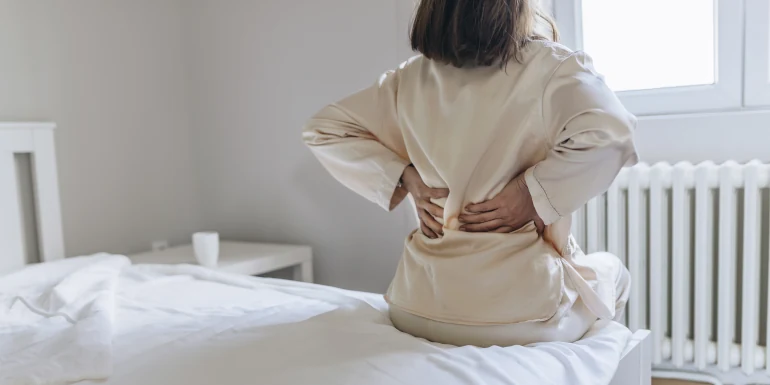
Chronic pain: what should you do?
Chronic pain is when you have already had acute pain for three to six months and it is not going away. Many things can be causing your pain and it can put a great strain on your mental health, too. Learn more about chronic pain syndrome here.
There are 1.5 million people in Switzerland suffering from chronic pain – most of them every day but some even more intensely. Everyone feels pain differently, so it is hard to judge or even compare individual symptoms. However, it is a fact that chronic pain massively impairs your quality of life. In order to treat chronic pain successfully, you need to know what is causing it.
What is chronic pain?
We all become aware of acute pain quickly: we feel it immediately on getting injured or ill. But what if this pain doesn’t subside? Pain is classed as chronic if you have felt it for three to six months or longer. When pain disrupts your everyday life, it is also referred to as “chronic pain syndrome”.
Chronic pain can develop after tissue damage, for example, where persistent pain stimuli put too much strain on nerve cells. These repeated pain signals can create a kind of “pain memory”, with patients registering even minimal pain stimuli as pain. These pain messages, which our nerves send to our brain, have been crucial for survival since time began because they warn us of danger. But with chronic pain, this “alarm system” in the body is thrown out of kilter.
Acute pain:
- occurs immediately during or just after an illness or injury
- can be addressed with conventional treatment and pain management methods
Chronic pain:
- occurs three to six months (or more) after an illness and is persistent or recurrent
- continues despite treatment efforts and painkillers
Chronic pain: symptoms
You can experience chronic pain in different ways – and it is very individual. Signs that show you are in pain include sweating and nausea, if you are scrunching up your eyes and if your forehead muscles are tense. High blood pressure can also result from pain.
Chronic pain: finding the causes
If your pain persists over a lengthy period of time, you should consult the relevant specialists. Doctors and therapists must first locate the pain and identify what triggers it. A patient’s medical history and how they describe their pain play just as important a role in this as physical examinations. The following questions help to define the pain:
- Do you have a pre-existing condition (e.g. cancer, diabetes, slipped disc)?
- Is the pain in your back, abdomen, arms, legs or head?
- Is the pain due to your spine, pelvis, muscles, joints or nerves?
- When does the pain occur, at what time of day?
- Does the pain occur more when you make certain movements or when your weight is on the affected area, or more when you are resting?
These questions allow chronic pain firstly to be located, and then possible causes can also be defined.
Headaches
Chronic headaches that you experience for 15 days or more over the course of three months in a row can be caused by poor posture, an accident or be a sign of mental stress. Symptoms of chronic headaches may also include loss of appetite, nausea or greater sensitivity to light, noise or certain smells.
Back pain
Over 90 percent of back problems are not due to slipped discs: they are caused instead by muscle tension, poor posture or not getting enough exercise day to day.
While acute back pain usually only lasts for a short time, it can develop into chronic back pain under certain circumstances. If the pain is very severe, the pain receptors in the person affected can “store” this feeling of pain – meaning that they will still feel it even when its cause has been cured. Lack of exercise due to adopting a relieving posture that doesn’t exacerbate the issue and illnesses such as rheumatism or osteoporosis can also contribute to chronic back pain.
Chronic pain: treatment
One way of dealing with highly complex and persistent chronic pain is multimodal pain management. This multidimensional treatment combines therapies from different areas, ranging from taking medication and painkillers to having physiotherapy and trying methods such as acupuncture.
Pain management for chronic pain is very successful for patients who are willing to make changes and are open to new treatment approaches. If body and mind can be brought back into harmony, the chances of curing chronic pain are good.
Chronic pain: mental health
Chronic pain sometimes has no physical cause. Mental suffering can hurt just as much, however. Our mind plays a big role in how we feel pain, but it is also vital in the process of overcoming chronic pain.
Psychological factors that can lead to chronic pain include:
- Sleep – in particular, disrupted sleep due to pain. Here, a lack of sleep leads to more pain: a vicious circle is created regarding the chronic pain
- Mood – your frame of mind, stress, trauma and depression can all increase the feeling of pain: for example, chronic pain can lead to depression, but depression can also trigger chronic pain
- Coping strategies – people who are socially and economically disadvantaged are more likely to suffer from severe and chronic pain than those from wealthier groups
Chronic pain with a purely psychological cause can also occur in rare instances, but this can only be diagnosed by a professional.
If our body cannot resolve these emotional tensions, physical complaints such as headaches, muscle tension, digestive problems and exhaustion may result. Should these pain symptoms become chronic, it is useful to consider psychotherapy, which can also help to promote resilience or, in other words, inner strength.
Pain that lasts for more than three to six months is deemed to be chronic. It is often difficult to pin down this chronic, severe pain – but with the help of experts and focused pain management, it is possible to get back on the path to a more carefree life. It is an indisputable fact that the mind also plays a major role in chronic pain. If you keep moving despite the pain you feel, learn to boost your personal resources and find out about possible forms of treatment, you have a good chance of living pain-free in the future.

The expert provided the editorial team with advice and input for this article. Tim Reck (anaesthesiology specialist) has worked in the field of pain medicine for 15 years. He is Chief Physician at the Swiss Paraplegic Centre in Nottwil (LU). The Centre for Pain Medicine uses a multimodal approach to treat all types of pain and covers the entire range of therapies.


Newsletter
Find out more about current health issues every month and get all the information you need about our attractive offers from all Helsana Group companies * delivered by e-mail to read whenever it suits you. Our newsletter is free of charge and you can sign up here:
We did not receive your information. Please try again later.
* The Helsana Group comprises Helsana Insurance Company Ltd, Helsana Supplementary Insurances Ltd and Helsana Accidents Ltd.